How to Pack for a Photo Trip
Introduction

Travel photography is one of the most exciting types of photography since it combines exploration, discovery and creativity. A travel photographer must capture the wonder and essence of each place while simultaneously discovering and navigating it. Success travel photography requires preparation to have the right gear for each outing as there is rarely the opportunity to restart.
There are many steps to take before traveling for photography. One of the most stressful can be packing, which is the focus of this feature article. Below we cover the what gear a photographer must pack, what rules apply when flying with electronics and which travel bags are right for the job. We also explore the different restrictions one might encounter. Read the sidebar to learn about camera bags for travel photography.
This article covers packing and describes multiple bags to use when traveling for photography. Peak Design kindly sent us their Travel Backpack 30L to review for this article. They have a collection of unique camera and travel bags that received critical acclaim. More on this below.
Travel Photography Gear
Cameras and lenses are obviously required for travel photography. One has to bring them to the destination while keeping them safe during travel and on location. There are many types of camera bags for various use cases which are covered in the sidebar. Travel photographers need to take much more that a camera with them and they have to do so with applicable rules and regulations, plus safety concerns.
Flying with Photography Gear
Air travel is more restrictive than any other common type of travel. There are rules in place by travel agencies and airlines that must be adhered to. Depending on the itinerary, it is entirely possible that different rules and regulations apply to certain flight segments. To easily travel through an itinerary, one must ensure to satisfy the most stringent requirements applicable.
Nearly every airline allows travelers to take on-board a carry-on and personal item. These are often confused by beginners but they have specific meanings and airlines have different rules for each item. Given the space required by equipment needed by a travel photographer, it is advised to avoid airlines which do not allow both as much as possible. The two major motivating factors which align here are rules and safety:
- Most airlines forbid travelers from packing valuable or electronics in checked luggage. This means that any such gear must be transported in the cabin, so having both a carry-on and personal item is essential.
- Even when it is allowed, packing electronics is risky. Baggage is handled roughly and passes through many steps. Each is an opportunity for items to break or go missing. Even temporarily lost luggage can take days to receive.
The bottom line is that you should avoid packing photography gear in checked baggage because it is risky and most times you cannot because it is not allowed. There is sometimes no choice for large gear which requires special precaution and having extra insurance but this is usually reserved for professionals.
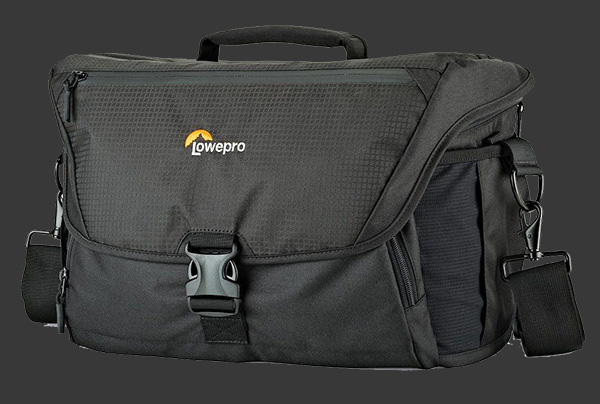
The above Lowepro Nova 200 AW II is among the best and most efficient camera bags on the market.
Camera & Lenses
Camera and lenses are almost always the most expensive a fragile items a travel photographer needs. Everyone must pack two or more cameras. One can be the main camera and the other a backup, in case the main gets damaged or stolen, or both can be used in tandem to minimize lens changes. In such case, it is advisable to pack a third camera stored separately at your destination, particularly where the risk of theft is higher.
Although not covered in this article, it is important to choose the right lenses and camera, if there is a choice, according to the destination and packing restrictions. Some all-in-one solutions exist but they invariably come with compromises.
Cameras and lenses, minus any backup item, normally go in a separate camera bag carried as a personal item. Make sure that yours satisfies applicable flight rules. Generally, the description and allowance for a personal item is highly flexible as long as it is smaller than the carry-on allowance. Here, Generally must really be emphasized as certain airlines do have very strict personal item rules. Within the camera bag, photographers should also carry extra memory, batteries, filters and a few more accessories. These are the ones required while photographing and so are usually well-known.
Travel Photography Equipment
A key aspect for traveling for photography is that one must have the right equipment available and accessible at the right time, while extra gear is required during the trip to support the activity. On top of having a few cameras, lenses, memory and battery, the travel photographer requires quite a few items:
- Chargers with cables and adapters according to the destination. Although uncommon, chargers can fail and so it is a good idea to have more than one. Choosing a main and backup camera that work on the same battery makes this easier. Some modern cameras are capable of charging via USB which is a nice-to-have backup but it is best not to depend on it. Charging over USB ties up the camera and forces it to be unprotected as it sits tethered to the charger for a while.
- Cables are needed at leas to charge the camera. Most people also need cables to charge their phones and laptops or tablets. The advent of USB-C has made this significantly easier and now that the European Union is forcing Apple to conform, nearly everyone should have the option. Pack 2 USB-C cables and 2 USB-C chargers, preferably multi-port models, if all your devices except for the camera work with USB-C. Otherwise, make sure that you have two cables that work for your phone and other electronic.
- Power Adapters that physically couple different types of plugs and outlets are sometimes needed. Only a few camera battery chargers take a USB-C input, so most will need one adapter to use with the battery-charger and one with the USB-C or laptop charger. These are nearly always voltage-switching chargers, so it is rarely required to have a voltage converter which is much heavier. Those who travel by car, especially overnight, should also pack a charger that take a 12V input.
- Laptop. Maybe a tablet instead under tight size or weight constraints. Most photographers like to review and inspect images on a screen larger than the rear LCD of a digital camera. Although most laptop screens are not color-accurate, they are always pixel accurate. The true reason why a portable computer is a necessity is go make backups while traveling. Some standalone devices can do this without a computer, but they are costly, slow and restrictive, which makes them not very popular.
For truly impressive performance in the lightest laptop yet, the Lenovo Thinkpad X1 Nano is the Neocamera Editor's Choice. This carbon fiber laptop features a display with 100% sRGB gamut and weighs just 2lbs. - A Memory Card Reader is highly recommended. These small devices allow fast transfers of images and videos from a memory card to the computer without using the camera, saving its battery power and allowing it to be kept in a safe place while copying files. Some multi-slots readers allow card-to-card copy to make external backups that can easily be hidden. It is advantageous to keep a backup outside of expensive electronics, like a laptop, to reduce changes of backups being stolen.
- Extra photography essentials: Lens and sensor cleaning tools and fluid, a microfiber cloth, lens tissues, etc.
- Extra photography gear as needed by the trip and photography needs: filters, step-up-rings, external flash, white-balance, remote trigger, etc. Plus additional gear for videography, if needed.
- A Tripod nearly always end up packed in checked luggage due to its size. Some photographers like to add a small foldable or bendable tripod in case something happens to the tripod. If night photography is expected to be frequent during the trip, this is a good idea. Read the Peak Design Tripod Review to learn about one of the most compact models available.
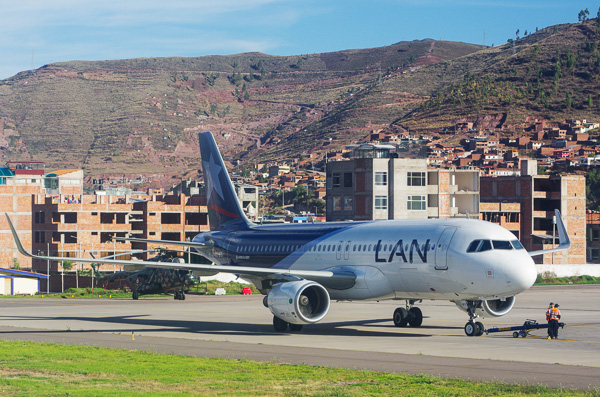
Travel Essentials
There are many items that must be taken on board when traveling, even when travel photography is not involved and so this must fit together with the above within the applicable allowance:
- Passport: It is small and light but absolutely essential for international travel and even helpful during domestic travel. Have copies of its main page and visas applicable to your travel.
- Documentation is now often received electronically but it is crucial to have paper copies to show at critical points. Some countries ask for proof of accommodation during immigration and it is advisable to have a paper to show quickly. Prescription medication can have supporting documents which helps when going to certain destinations. Vaccination proofs are more needed than ever.
- Medication must be taken on board with you. This should preferably be in their original container with the pharmacy label. Take also bono-presiption medication with your for common ailments to avoid suffering through travel or scrambling at your destination.
- Basic toiletries are to be taken on board. Have at least a toothbrush, floss, dental paste, deodorant, sanitizer and some sunscreen. Nowadays, people will also take disposable and reusable masks.
- Personal Electronics: Cellphone, headphones, audio player, ebook reader, etc along with any cables and chargers required. Again, converging to USB-C makes this significantly simpler. A flashlight or headlamp is a good idea to have.
It is easy to see how the bulk and weight of everything adds up quickly. There are always other items that people deem essentials to be packed on board, such as earplugs, sunglasses, underwear, hat, etc. Make sure to select each item to ensure that this does not become excessive.
Travel Photography Carry-On
Given everything that must be taken on board, a travel photographer needs a large carry-on. Although carry-on limits vary by airline, maximum allowed dimensions are all very close yet the maximum allowed weight varies enormously. Nearly all airline carry-on limits are 21" or 22" by 15" or 14" by 9" or 8". Therefore a 21" x 14" x 8" bag would be accepted by the vast majority of airlines. Surprisingly, it is rather difficult o find something other than a roller suitcase with exactly those dimensions.
Weight is difficult to work around. There are several major airlines, mostly North American ones, with no weight limit to the carry-on, as long as the traveler is able to lift it unassisted into an overhead bin. More common restrictions are 22lbs (10kg) for pricier fares and major airlines or 15lbs (7kg) for economy and low-lost carriers. Some go as low as 11lbs (5kg). To make thing worse, certain airlines specify the weight limit as combined carry-on and personal item.
Comfort and usability are also important considerations. One must be able to travel with the packed gear, access it and store it back efficiently. Given security concerns, travelers are often asked to take out laptops, electronics and liquids during screening which makes convenient access very important.
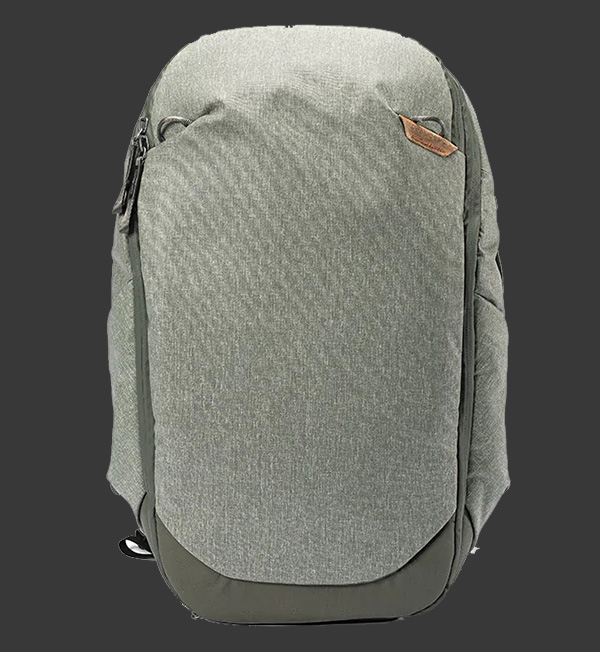
Peak Design Travel Backpack 30L
A crowd-funded camera carrying system launched Peak Design to fame, which they followed with a number of photography products. Recently, they expanded to general travel category. Although not specifically aimed at photographers, their new Travel Backpack series is a great fit for travel photographers. There is a 30L and 45L model in the series with some choice of colors. Both these bags are expandable models. With Travel Back 30L, which we got a chance to review for this article, expands to nearly the carry-on limit, while the 45L model starts near the carry-on limit and expands from there. Their design is virtually identical though.
Externally, the Peak Design Travel Backpack 30L is very minimalistic. It has a more rectangular shape than most backpacks which allows it to fully utilize the volume available to a carry-on bag. In its unexpanded state, it measures 21" x 13.4" x 7" for a 27L volume. A compression zipper releases extra fabric so that its depth expands to 8", giving it a 33L volume. The weighs 3.6lbs (1.7kg) which is a little higher than the official specifications.
Space within this backpack is divided into a huge main compartment with dedicated slots for a laptop and tablet, four internal pocks and an shallow secondary compartment with inner pocket. There is an open stretch pocket on each site, plus straps and attachment points. A pair of deep slots can store an up to a 16" laptop and 11" tablet.
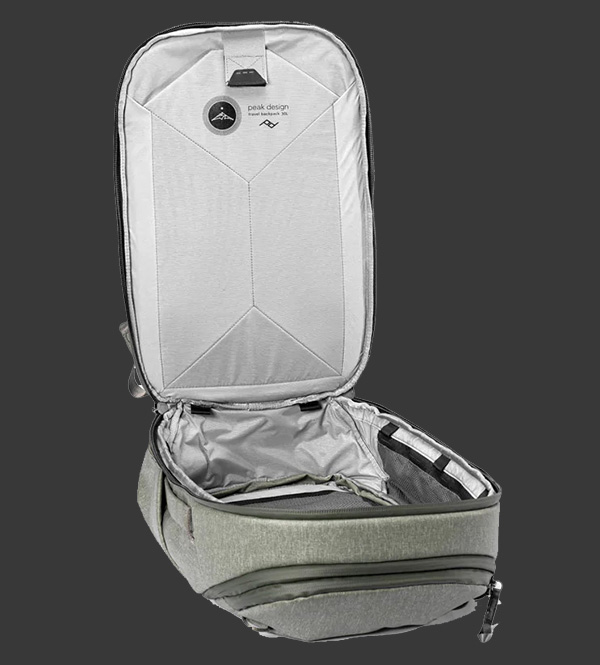
The standout feature of the Travel Backpack 30L is its incomparable access. The main compartment opens by unzipping the back of the backpack fully on three sides. It flips open to leave the largest surface completely open. It becomes extremely easy to organize and access anything inside the backpack this way. Given that the front is virtually flat, the backpack rests with excellent stability during access.
Both the laptop and tablet compartment are found together on the back of the backpack. Since that is the side that opens and the flex point is elevated when the backpack is accessed, these slots point down at that point. To avoid them slipping out, Peak Design stitched a sturdy Velcro with a wide elastic band. The downside of sharing the main and laptop compartment opening is that, it is fiddly to take out the laptop without resting the backpack on its front. This is sometimes required when going through airport security as busy airports.
Two mesh zipper pockets are easily accessible vertically. These are ideal for small items that can be needed without unpacking the entire bag. Two larger pockets are found inside at the bottom of the main opening. When the bag is full, there are completely covered and inaccessible yet Peak Design prepared a solution for this.
Packing cubes are widely appreciated by many for the way they help organize the inside of luggage. Normally, these are simple square bags with a zipper. Peak Design created much more sophisticated packing cubes that evenly subdivide their travel bags. These cubes come in Small and Medium size. One of each together fit the expanded Travel Backpack 30L exactly. By placing items in two such cubes, the inner compartments of the backpack can be easily accessed.
Peak Design packing cubes are made of an extremely light material with a very smooth finish. It is incredibly thin yet feels quite durable. Unusually, there are three zippers on this packing cubes. The main zipper features double pulls and a pair of tabs that can be used to completely open the cube. A second zipper wraps around the entire cube to compress its content. Unfortunately, this does not work. Due to the low resistance of the main zipper, any attempt to close the compression zipper while the cube is packed cause the cube to open on the other side. The third zipper gives access to the opposite side of the cube to that items can be shifted from one side to the other as they are used. These cubes are the only valiant attempt to improve open packing cubes. They are certainly high quality and light yet just do not quite manage what they are attempting.
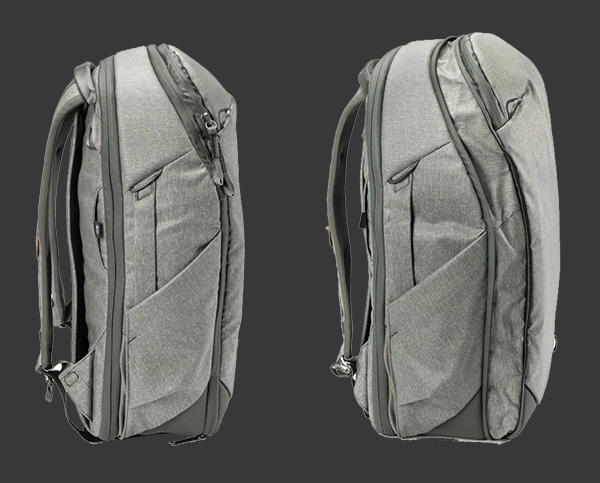
Back to the backpack, there is a shallow compartment at the top of the pack to place items that must be accessed quickly. Unlike most backpacks that place a small front compartment at the bottom which makes items sink into the bag, this one keeps its content much more accessible. The compartment is further subdivided into three open pockets and one zipper pocket. Its great to have a pocket inside to avoid small items to accidentally escape.
The rear of the backpack has a very unusual design made of multiple layers. A slim handle at the top serves to carry the backpack by hand, while another slim handle serves as luggage pass through to stabilize the bag on top of a roller suitcase. The latter handle is mounted on a padded panel 2/3 of the width of the bag. This panel is attached to bag in the middle, so that its shoulder straps can be hidden behind it. The goal is to reduce chances of shoulder straps getting entangled in some thing yet there are less bulky ways to prevent this.
A small semi-open pocket at the back can hold a few business cards. The last items of note on the bag are six anchor points, four on the back, two on the front. These serve to attach additional some items to the outside of the backpack. Extra accessories are required to use these.
The materials used all around the Peak Design Travel Backpack 30L are truly high quality. The rugged texture of the main fabric makes it abrasion resistant. The bottom of the bag is made of a thicker waterproof synthetic material, while the rest is treated for water resistance. The entire outer shell of the bag is padded to absorb shocks and protect equipment inside. What obviously lacks padding are its shoulder straps which make the bag feel heavier than it actually is when fully loaded. Speaking of weight, this backpack is unusually heavy at 3.6lbs (1.7kg). The double back contributes somewhat here.
The Travel Backpack 30L is one of the most usable backpacks for any type of travel. Its wide flip out opening makes accessing and organizing its contents extremely comfortable. It has enough compartments to organize items and keep small ones in place. Having a large main compartment means that it can realize much of its advertized volume, something which many backpacks do not manage.
Weight is the main downside of this backpack. As mentioned earlier, several airlines do not have a specific weight limit for carry-on items but, for that that do, it could be 14-20% of the allowance without anything inside! Its thin shoulder straps also makes this weight felt. Lastly, access to the laptop compartment without placing the bag down on its front is fiddly.
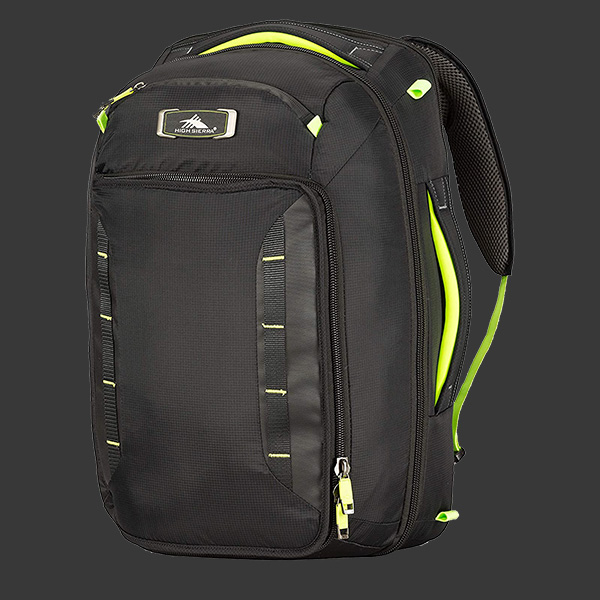
High Sierra AT8 Convertible
One of the few bags that closely fits nearly every carry-on allowance is the High Sierra AT8 Convertible. In contrast to the streamlined Peak Design Travel Backpack 30L, the AT8 is a veritable swiss-army-knife of travel bags. This convertible bag switches from a backpack to a shoulder bag to a briefcase in minimal time.
The High Sierra AT8 measures approximately 22" x 14" x 8" and weighs in 2.8lbs. This relatively light bag has a flexible contour which allows it be give away at least an inch in each direction. This is incredibly practical to push it into a bag sizer that may be slight smaller officially. Speaking of stretching numbers, High Sierra specifies the weight as 2.1lbs which must have been measured under different gravity!
Nearly 40L can be packed into this carry-on bag. Most of its volume is located in a huge main compartment that can be split into two by a thin mesh that closes using a zipper. This allows the AT8 to store bulk items. There are two large inner zipper pockets plus huge slots at the back to accommodate both a 17:laptop and 13" tablet. An extra fairly large zipper pocket for quick access is found at the top of the back, when used in backpack mode.
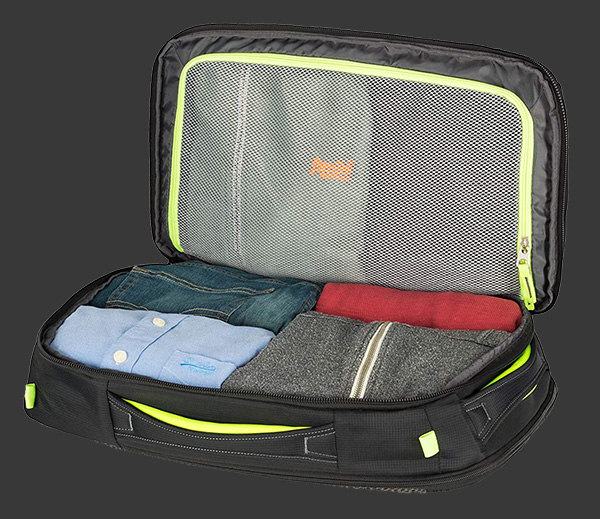
Accessing the space within the High Sierra AT8 Convertible is too convenient! Three zippers allow the traveler to reach most of the content in the bag. Two zippers open on three sides, allowing two different sections of the bag to open as lids, while the third opens on two sides to quickly access contents from back of the bag. With the divider closed, a quarter of the volume can flips away from the remainder of the bag. All openings feature double zippers so that an opening can be created suitably to the carrying mode.
All this convenience and flexibility creates an unexpected issue. One has to be exceptionally careful not to spill the bag contents while opening the bag. It also makes it very easy for someone to slip things out of the bag unnoticed. The best strategy to deal with this is to select an opening, according to the desired mode, and lock the other entry points shut with a twist-tie or simple luggage lock. For the most convenient access to everything except the laptop and tablet compartments, use the middle zipper for access. Of course, then the laptop is harder to reach and there is no good solution for this. When opening from the middle zipper, it is crucial to ensure the mesh divider is closed, otherwise content will spill.
Handles on one long and one short side provide an easy way to carry the AT8 by hand. These soft handles are well padded for comfort. A detachable strap is provides for using as a shoulder bag. This is the least ergonomic mode since this relatively thin strap is made of nylon which gives little traction. The way most people will carry this bag is as a backpack using two medium width and padded shoulder straps that can be sealed completely behind the back panel of the bag. This removes all chances of entanglement.
It is easy to pack plenty of gear inside the High Sierra AT8 Convertible and it offers the most versatile carrying options of any bag. At the same time, the design of this bag feels very much indecisive. Opening it can easily make mess and cause content to fall out. The many zippers without proper locking clamp eyelet and soft fabric make this bag even less secure than most.
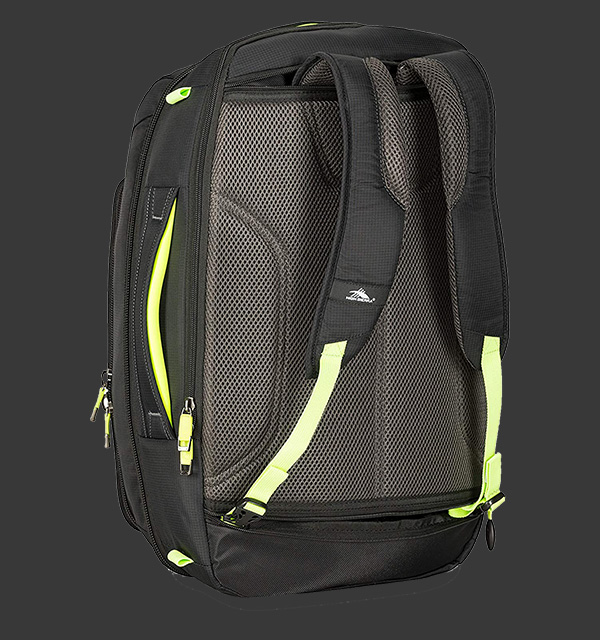
With three modes to select, it is impressive that High Sierra managed to made this bag fairly light, yet not as much as they claim. The result of this flexibility is that no carrying method is truly comfortable. Having extra wide and more padded straps would have increased the weight substantially since there are three straps and two handles. That being said, this ultra-flexible bag can carry more than practically any carry-on in terms of volume and also leaves more weight allowance than most.
For the most part, the High Sierra AT8 is well constructed. Materials are sturdy and lightweight yet on the thin side in favor of weight. Its textured finish looks a little underwhelming, especially compared to premium materials on the Peak Design backpack. Water resistant coatings have been applied all around the bag and the top pocket zipper is rubber-coated to make it waterproof. This bag has a lot zippers though and it should probably not be kept under rain for long. The only part that does not work effectively is the shoulder strap which is optional.
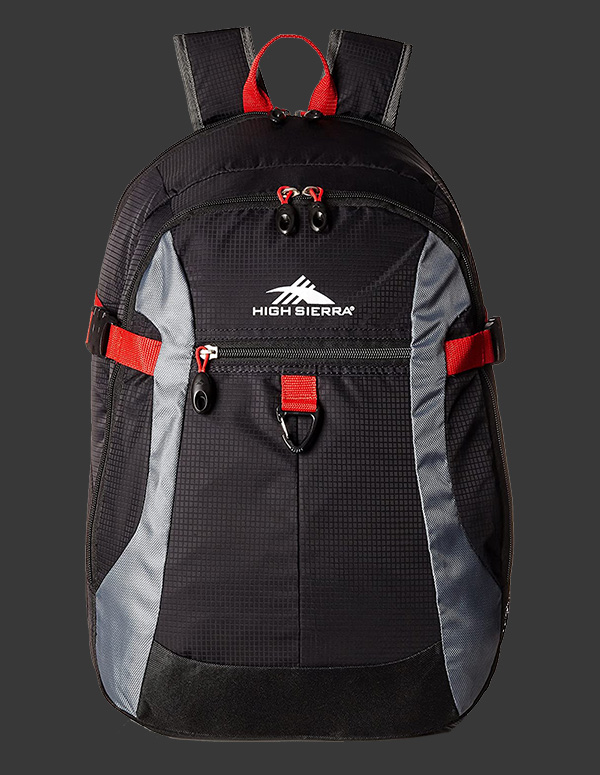
High Sierra Sportour Backpack
While the travel bags reviewed above are specialized carry-on luggage designed to meet airline requirements, it is important to consider a simple lightweight backpack such as the High Sierra Sportour. This particular model officially has outer dimensions similar to typical carry-on limits yet its tapered design means it pack less volume.
The High Sierra Sportour is a laptop backpack commonly uses as a school bag. It is composed of a think nylon shell attached to a padded back panel measuring 21" x 14". The shell can extend up to 9" from just 1½" when completely flat. Most of the volume of this bag is enclosed within a single main compartment. Inside the compartment, there is a lightly padded slot that can hold a laptop up to 17" and a second unpadded slot for documents or a large tablet. A deep secondary compartment can hold a substantial volume. One outer pocket and two small inner ones, plus a mesh side-pocket round off this backpack.
There are many advantages to the High Sierra Sportour. Its most exceptional feature is extremely light weight. This backpack weighs a mere 1.6lbs (725g). Let that sink in for a moment. Although it has similar dimensions to most carry-ons, it weighs 1.2lbs less than the High Sierra AT8 Convertible and two full pounds less than the Peak Design Travel Backpack 30L! When traveling with airless having stricter weight limits, this difference in weight makes a huge difference. This backpack folds nearly flat and is comparatively inconspicuous.
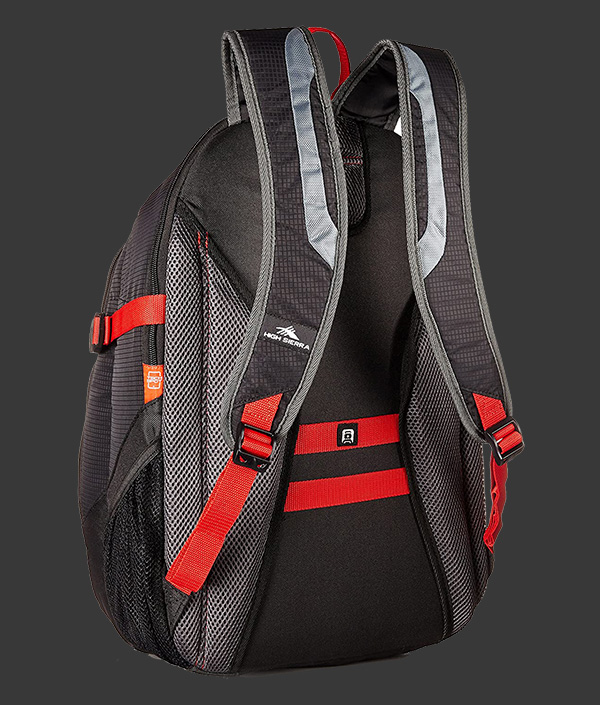
Two lightly padded shoulder straps make carrying the Sportour Backpack relatively comfortable. A small padded area near the top and a strip of mesh padding on each side enhance comfort while providing airflow. When fully loaded, it can feel heavy yet larger more padded straps would have increased its weight.
After trying out dedicated carry-on bags, the main disadvantage of such a backpack becomes obvious. With only an opening in the top half of the main compartment, it is difficult to organize content within this bag. Lower items are weighed down by those on top. The laptop slot is also easily obstructed by items when the bag is completely full. The secondary compartment is of a decent size yet is nearly impossible to fill completely since it is too deep relative to its thickness.
This packpack is well made yet uses generic materials, mostly nylon. The bottom panel is reinforced with thicker nylon. These materials allow the High Sierra Sportour backpack to be lightweight and look inexpensive. When traveling, this is often a good thing since it attracts less attention than a high-end bag.
Travel Photography Packing
After proper planning, packing for travel photography is straightforward. The best way is to start with an itemized checklist, such as the one at the start of this article, and run over to avoid forgetting anything. It is good idea to have it printed and check off items as they get packed. Leave the list on top of the bag until all items are in.
Certain items have dedicated locations. Those are camera bag compartments, slots for laptops and tablets, among a few things. Those generally go in first, followed by large items in order from least used to most used. Follow that with small items, again inversely ordered by usage. Keep small objects together within accessory pouches that group related items.
Place items likely to be accessed first after everything else is packed, except for laptops or tablets that have their own space. Place liquids in a single transparent zip-lock bag into the carry-on last. Insert objects that will be required between home and your destination into a quick access pocket. This includes passports, a pen and miscellaneous items such as earplugs, wipes and masks. Once the passport has been shown where required, move it to your person, if possible to minimize risk of theft. Many flights have charging ports now, so leave a cable in the quick access pocket too.
Zip-lock bags are extremely useful. Always pack several and use one for electronic items to keep them dry and one for food items to keep them from spilling. Many snacks come is tearable bags that spew crumbs everywhere, so zip-lock bags are ideal to contain the mess. Pack an extra pen within reach to fill out forms when needed.
For extra peace of mind, take luggage locks are twist ties to close openings in your bags. These do not keep an unattended bag safe but greatly reduce chances of opportunistic theft. For more robust solutions, portable safes and metal meshes are available but those are always relatively heavy.
When returning from a trip, memory cards will be filled with irreplaceable memories. Ideally, these would all be backed up. Whether backups are in duplicate memory cards, USB drives or a laptop, they must be kept separate from originals. Originals can go in the camera bag and the backup in the carry-on. Alternately, a copy made onto memory cards can easily be carried on yourself in a money-belt or pocket. Just remember about it when going through security.
Ensure that all required items are accounted for and weigh everything together and cross check with the applicable luggage allowance. There will be some hard decisions to make if over the limit. Otherwise, one can select extra items that can make the trip more enjoyable. Avoid reaching exactly the maximum when possible. Having additional photo accessories can add variety to your photography.
Please Support Neocamera
All information on Neocamera is provided free of charge yet running this website is a huge endeavor. Purchases made via affiliate links found throughout the site help keep it running and up-to-date. There is no additional cost to you, so please consider buying via these links to our affilates:
Thank you for your support!
Camera Bags
Camera bags come in a wide variety of form-factors and sizes. The main driving factors in selection a camera bag are size and access. The most efficient camera bags are actually shoulder bags which keep gear accessible and within view at all times. On the other extreme, backpacks can make carrying gear more comfortable yet time and effort is required to reach it. Sling bags compromise right in the middle by switching from the back to the front in one swift movement.
A camera bag must be sufficiently large to carry the photo gear needed for a day of shooting yet it must also fit within the limits of a personal item. This varies tremendously between airlines, anywhere from tight limits to unspecified ones. Make to check rules before purchasing a ticket when you are travelling with separate carry-on luggage.
Neocamera reviewed a number of Think Tank Photo camera bags over the years:
- Think Tank Photo Story Teller 10 Review [Shoulder]
- Think Tank Photo Spectral 10 Review [Shoulder]
- Think Tank Photo Photocross 13 Review [Sling]
- Think Tank Photo City Walker Review [Shoulder]
- Think Tank Photo Street Walker Review [Backpack]
- Think Tank Photo Speed Freak V2.0 Review [Shoulder / Belt]
- Think Tank Photo Shape Shifter Review [Backpack]
- Think Tank Photo Sling-O-Matic 20 Review [Sling]
- Think Tank Photo Urban Disguise 70 Pro V2.0 Review
[Oversize Shoulder]
It is necesary to balance the convenience of carrying a camera bag while traveling to a destination with that of carrying it while traveling at the destination. Certain types of travel photography require a more comfortable bag that can be work over extended periods. Others require faster access to gear.
Most shoulder bags are acceptable to at least major airlines as personal item. Backpacks, however, are designed to carry more gear and would often be too large. Slings tend to be on the smaller side. Keep in mind that one must carry both the carry-on and personal item together and is it difficult to carry two of the same type. The simplest is have one shoulder bag and one backpack.
Updates
2025.11.13

Best Gifts for Photographers in 2025 by Budget
The annual Neocamera Photography Gift Guide updated to 2025. Find great gifts for photographers with any price budget.
2025.07.07

Stellar Photo Recovery Review
Review of Stellar Photo Recovery V12. This Windows and MacOS software can recover photos and videos in a huge number of formats from memory cards, USB drives, SSDs and HHDs.
2025.05.14

Huion Kamvas 13 Gen 3 Review
In-Depth review of the Huion Kamvas 13 Gen 3 Pen Display Tablet for photographers and graphic artists.
2025.01.18

Fujifilm GFX 2025 Lens Roundup
Lens Review roundup of Fujifilm GFX Medium-Format lenses. Quality, performance and handling of the GF20-35mm F/4R WR, GF30mm F/3.5 Tilt-Shift and the GF55mm F/1.7.
2024.11.18

Best 2024 Photography Gifts for Every Budget
Great gifts for photographers and photo enthusiasts selected for every budget among the best products of 2024.
2024.08.07

Eye Protection Tips for Professional Photographers
The four main considerations for professional photographers regarding eyewear.
2024.07.14

Fujifilm X100VI Review
Flagship fixed-lens compact digital camera with a 40 MP sensor and Image-Stabilization, a first for the series. Retro design featuring dual control-dials, plus direct ISO, Shutter-Speed and EC dials. Its hybrid viewfinder can switch between EVF and OVF mode.
2024.05.09

Fujifilm GFX100 II Review
Flagship 102 Megapixels Medium-Format Mirrorless Digital Camera with 8-Stop 5-Axis IBIS, 8 FPS Drive, 8K Video and 400 MP Super-Resolution capture in a weatherproof and freezeproof body with dual control-dials and dual memory-card slots.
2024.04.03

Fujifilm X-T5 Review
Newest Fujifilm flagship boasting a 40 MP APS-C sensor, 5-axis IBIS with 7-stop efficiency, 15 FPS continuous drive, 6.2K Video capture, dual control-dials and dual SDXC UHS-II slots in a sturdy weatherproof and freezeproof body.
2023.11.20

Best Digital Cameras of 2023
Find out which are the Best Digital Cameras of 2023. All the new Mirrorless Digital Cameras from entry-level to high-end professional.
2023.07.10

Fujifilm X-H2 Review
40 Megapixels APS-C Hybrid Mirrorless Digital Camera with 7-stop IBIS. Fastest shutter ever and 8K video capture. Large builtin EVF with 0.8X magnification and 5.8 MP, plus an Eye-Start Sensor. Packed with features and large number of controls in a weatherproof and freezeproof body.
2023.05.07

Sony FE 20-70mm F/4G Review
Review of the unique Sony FE 20-70mm F/4G lens. The optical zoom of this lens spans ultra-wide-angle and medium focal-length coverage, making it one of the most versatile Full-Frame lenses on the market.
2025.11.13
2025.07.07
2025.05.14
2025.01.18
2024.11.18
2024.08.07
2024.07.14
2024.05.09
2024.04.03
2023.11.20
2023.07.10
2023.05.07
NEWS
2025.12.02

Sony Upgrades Alpha 7 to 5th Generation
Digital Camera ○ Lens
2025.11.29

Venus Optics Releases New Zero-D Tilt-Shift Macro Lens
Lens
2025.11.23

Best Digital Cameras of 2025
Digital Camera
2025.11.14

Photography Gift Guide 2025 Edition
2025.11.06

Canon Announces Third-Generation R6 Mirrorless
Digital Camera ○ Lens
2025.10.23

Fujifilm Launches X-T30 III Plus New Wide Zoom
Digital Camera ○ Lens
2025.10.21

Peak Design Unveils Field Plate and Form Straps
2025.10.16

Nikon Unveils Z-Mount DX Lens Duo
Lens
2025.10.16

Venus Optics Unveils Fast Telephoto Prime Lens
Lens
2025.10.01

Think Tank Photo FocusPoint RollTop Backpacks
Bag
2025.09.30

Sony Produces Super Macro GMaster Lens
Lens
2025.09.17

Venus Optics Created First Telephoto Ultra-Macro Lens
Lens








